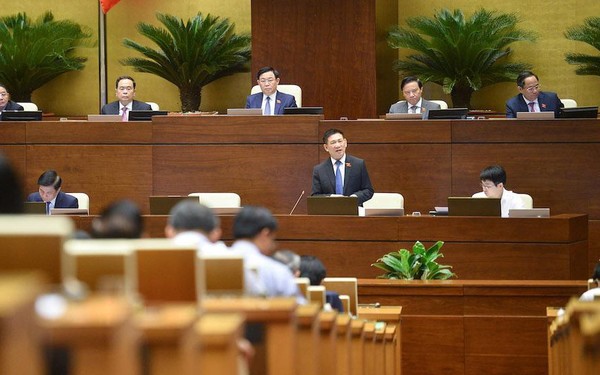Proposing COVID-19 as an occupational disease, entitled to social insurance
According to the draft circular stipulating the addition of COVID-19 disease to the List of occupational diseases entitled to social insurance, occupational COVID-19 disease is a disease arising during the working process due to the employee’s exposure to the SARS-CoV virus. -2 is present in the working environment.
According to the guidance on diagnosis and assessment of occupational COVID-19 disease in this draft, Common occupations, occupations, and sources of exposure to SARS-CoV-2 include:
People working at medical establishments.
Professionals, laboratory workers, taking samples, transporting samples, handling, preserving and destroying samples of SARS-CoV-2.
People working in concentrated isolation areas, medical isolation at home, medical isolation in epidemic areas, support to care for COVID-19 patients at home.
People who do jobs, transport and serve COVID-19 patients.
Persons engaged in the transportation, burial, preservation, cremation and burial of the bodies of COVID-19 patients.
Persons engaged in epidemic prevention, service and relief work for people infected with SARS-CoV-2 include: monitoring, investigation, and verification of the epidemic; diplomatic customs officers, immigration officers; officers, professional soldiers, non-commissioned officers, soldiers, defense civil servants, national defense workers and employees; soldiers and officers of the police force; people doing other occupations and jobs assigned to participate in the prevention of COVID-19 epidemic.
These cases have the minimum exposure time (the shortest time of exposure to harmful factors during the work process to cause occupational diseases): once. The period from the time the worker has stopped being exposed to the harmful factor to the time when the disease is still possible due to the harmful factor is 28 days.
Dossiers of entitlement to occupational disease policy with a diagnosis of COVID-19 disease must be accompanied by a hospital discharge letter or a summary of the medical record of COVID-19 disease, or a positive test result for SARS-CoV virus. -2 by RT-PCR technique or equivalent test according to regulations of the Ministry of Health.
Some of the main sequelae after recovering from COVID-19 include:: Body as a whole: persistent symptoms such as fatigue (ICD-10: R53), arthralgia (ICD-10: M25.5), myalgia (ICD-10: M79.1), taste disturbances (ICD). -10: R43.1), smell disorder (ICD-10: R43.2), hair loss (ICD-10: L65).
Respiratory: dyspnea (ICD-10: R06.0), cough (ICD-10: R05), reduced lung ventilation function (ICD-10: R06.8), Interstitial pneumonia, pulmonary fibrosis (ICD-10: J84) ), Pneumonia (ICD-10: J12).
Heart: arrhythmia (ICD-10: I49.9), myocarditis (ICD-10: I41.1), coronary infarction (ICD-10: I21), myocardial fibrosis (ICD-10: I42. 3), chest pain (ICD-10: I20.9), hypertension (ICD-10: I15.8).
Nerve: Persistent headache (ICD-10: R51); Sensory disturbances (ICD-10: R20); Motor paralysis (ICD-10: G83.9); Cranial nerve palsy (ICD-10: T90.3); Epilepsy (ICD-10: G40); Late-onset Guillain Barré syndrome (ICD-10: G61.0).
Autoimmune encephalomyelitis after COVID-19 infection (ICD-10: B94.1); Gastrointestinal: hepatitis (ICD-10: K75.9)
Urinary kidney: impaired renal function (ICD-10: N18.9).
Mental: Cognitive disorders (ICD-10: F06.7): attention, memory, intelligence, executive function; Conduct disorder (ICD-10: F62.0): abnormal behavior, substance abuse, personality changes, addiction to behaviors such as games/internets; Psychotic Disorders (ICD-10: F23.0): delusions, hallucinations, agitation, hypertonia; Mood disorders: mania (ICD-10: F30), depression (ICD-10: F32), mood disorder (ICD-10: F34.1);
Stress related disorder: acute stress response disorder (ICD-10: F43.0), anxiety disorder (ICD-10: F41.3), adaptation disorder (ICD-10: F43.2), somatic disorder chemistry (ICD-10: F45.0);
Sleep disorders: difficulty sleeping (ICD-10: F51.2), insomnia (ICD-10: F51.0), poor sleep (ICD-10: F51.2), excessive sleep (ICD-10: F51.1), evil dreams (ICD-10: F51.5), somnolence (ICD-10: F51.3);
Eating disorder: bulimia (F50.2), anorexia nervosa (ICD-10: F50.0;
Sexual disorder: frigidity, loss of desire (ICD-10: F52.0), abnormal sexual behavior (ICD-10: F52.8);
Life instinct (ICD-10: F43.1): self-harm, suicide.
Period of examination to determine sequelae: after 6 months since COVID-19 infection.
“The above workers who are diagnosed with COVID-19 disease between February 1, 2020 and before the effective date of this Circular are entitled to make occupational disease records, get an assessment and enjoy benefits. occupational disease according to the regulations…”, the draft circular of the Ministry of Health stated.
at Blogtuan.info – Source: cafebiz.vn – Read the original article here



